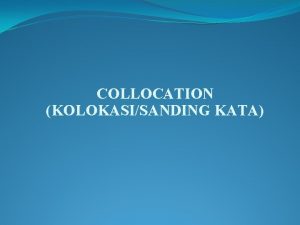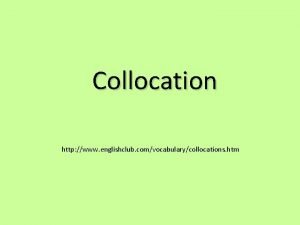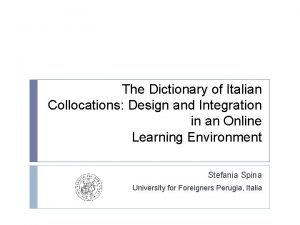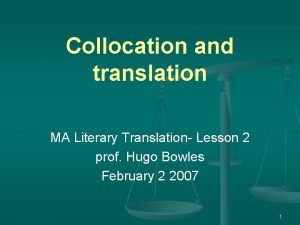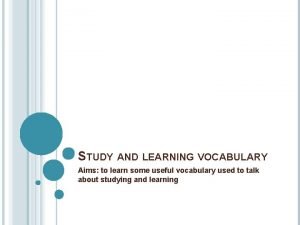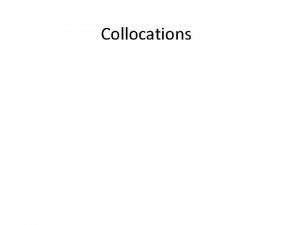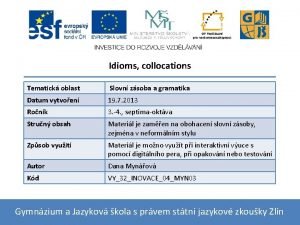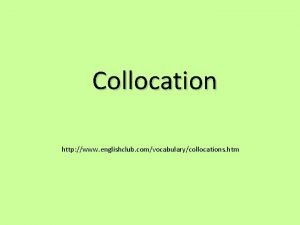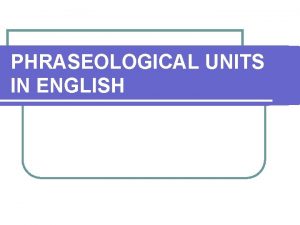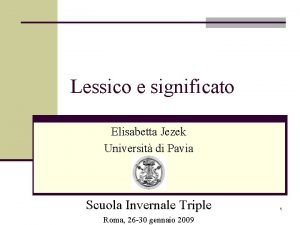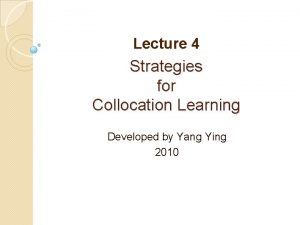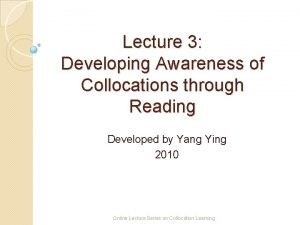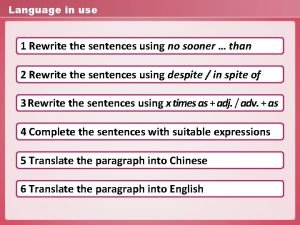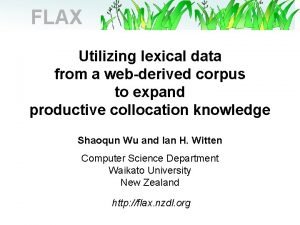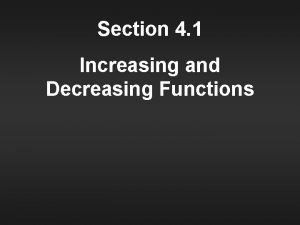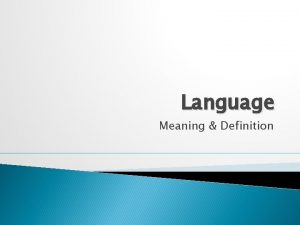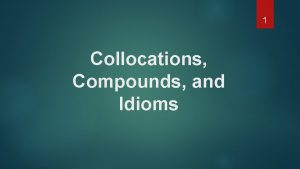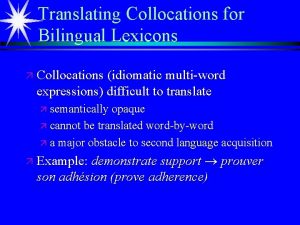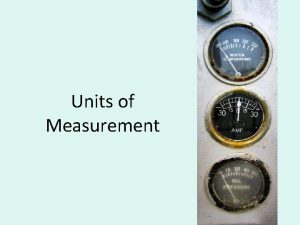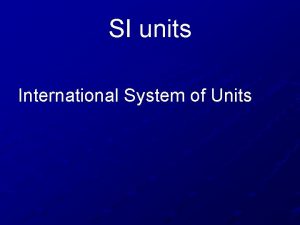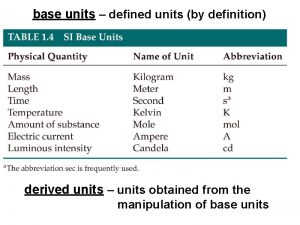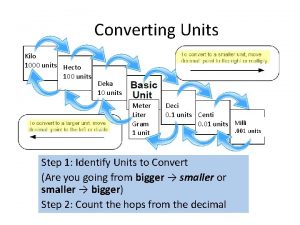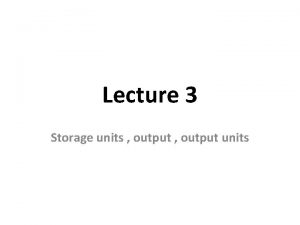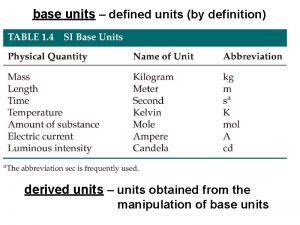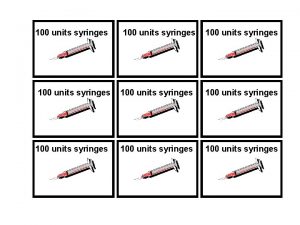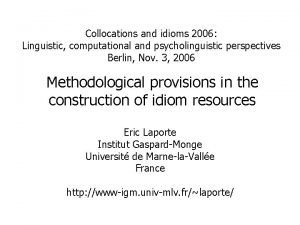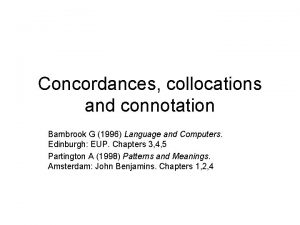COLLOCATIONS AND UNITS OF MEANING The increasing use























- Slides: 23

COLLOCATIONS AND UNITS OF MEANING

The increasing use of corpora has allowed researchers to identify systematically sets of words frequently co-occurring in language which are called collocations. These sets of words have been variously defined. However, according to their nature they can be divided into associations of words where one item can be replaced with no change in meaning – that is to say open collocations (to go to school, to get to school etc. ) – and associations of words whose components are fixed and cannot be replaced by any other elements – that is to say idiomatic collocations (as cool as a cucumber, as soon as possible). # As Firth states, words do not occur in isolation and, for this reason, they should be studied in their linguistic context and their patterns of occurrence should be systematically taken into account.

FIRTH AND THE NOTION OF COLLOCATION The British linguist J. R. Firth was the first to elaborate the concept of collocation. Firth distinguishes between “general or usual collocations” and “more restricted technical or personal collocations”. The words horse, cow, pig, swine, dog are used with adjectives in nominal phrases, and also with verbs in the simple present, they are common, have no specific features of their use, at the same time their use is restricted to the context of farming and people who are related to it (so, their collocations are restricted). # The word ‘time’ can be used in collocations with or without articles, determinatives, or pronouns. And it can be collocated with saved, spent, wasted, frittered away, with presses, flies, and with a variety of particles, even with no (collocations with time are general). # Firth assumes that the meaning of words is not fixed and independent but it is strictly correlated with the context it occurs within. His well-known slogan “you shall know a word by the company it keeps” exemplifies this strong dependence of words on their use and on their possible collocations. He is talking about level of collocating. The habitual collocations in which word cows can be used are “They are milking the cows”, “Cows give milk”. The word tigresses or lionesses are not so collocated and are already clearly separated in meaning at the collocational level. So, these words have low level of collocating. Words like time, hand, take, get have high level of collocating. # Firth observes that the collocation of a word is not just a “juxtaposition” but it is an order of mutually expectancy. This is why he refers to “meaning by collocation”: One of the meanings of night is its collocability with dark, and of dark, of course, collocation with night. #

SINCLAIR AND HIS IDEAS OF COLLOCATIONS Firthian theories, briefly described above, were taken on and developed by Sinclair, who was one of Firth’s students at Edinburgh University. As the title of his book “Corpus Concordance Collocation” (1991) clearly shows, he considers the notion of collocation in the light of corpus evidence and defines collocation as follows: Collocation is the occurrence of two or more words within a short space of each other in a text. The usual measure of proximity is a maximum of four words intervening. Collocations can be dramatic and interesting because unexpected, or they can be important in the lexical structure of the language because of being frequently repeated. (. . . ) Collocation, in its purest sense, recognizes only lexical co-occurrence of words. Sinclair considers collocation as the co-occurrence of two or more words in a span of maximum four words either on the left and on the right of the word analyzed. The following example is taken from a corpus of BBC articles dealing with the economic crisis and downloaded in a period from February and March 2011. The node word chosen is downturn: onal 9, 000 jobs as the global economic downturn hits demand for raw said that the effects of the economic downturn were difficult to onment of unprecedented global economic downturn, ” said the Australian finances have been hit by the economic downturn. The European all in UK car production The economic downturn has hit car production have been particularly hard hit by the downturn. They account for about

Frequent collocates of downturn are immediately visible on its left and are constituted by economic and global. However, a closer look at the concordance also reveals the presence of another collocate, the verb hit, which may also be found at a distance of three or four items on the left of the node word, that is to say in a “maximum of four words intervening”. Words occurring in positions L - 5 (that is to say on the left (L) of the node word and at a distance of 5 items from it) and in position R+5 (that is to say on the right of the node word and at a distance of 5 items from it) are not usually collocates. This example clearly shows how “words enter into meaningful relations with other words around them” and make meanings by their combination. The word downturn means “a reduction in economic or business activity” but the combination with global and economic adds more details to it, thus making it acquire the meaning of global recession. The phenomenon of collocation describes the strong attraction existing between words. According to Sinclair (1996), if words attract themselves, words in texts cannot be chosen independently of one another. There exist lexical constraints which operate at the level of word choice and since their effects are visible on repeated language patterns they can be systematically counted analyzed (for example, hit and knock have similar meanings, but when we talk about the door, only knock is possible). #

In the example below, the node word is expected as used in a corpus of UK weather forecasts downloaded from the website www. metoffice. gov. uk in a period ranging from February to March 2011. The use of this word in the language of weather forecasts is lexically constrained as shown by some examples reported below: Unsettled and sometimes windy weather is expected through this period, frosts and overnight fog. Temperatures are expected to be generally near and central regions, the drier weather is expected to continue, with temperatures are expected to be close to or The word expected mainly occurs with the words weather and temperatures which represent the lexical constraint in its usage. It should be borne in mind, however, that language patterns should occur a minimum of twice to be considered worth analyzing. The isolated meaning of expected would not help us understand the meaning of the pattern because it is the combination of the meanings of temperatures or weather plus the verb expected which explain the overall meaning.

OPEN-CHOICE PRINCIPLE AND IDIOM PRINCIPLE If words attract themselves, therefore, complete freedom of word choice as well as complete determination is very rare. For this reason, Sinclair elaborates two principles which account for how language actually works and which explain the way in which meaning arises from language text: the open-choice principle and the idiom principle. According to Sinclair (1991), the open-choice principle is a way of seeing language text as the result of a very large number of complex choices. At each point where a unit is completed (a word, phrase, or clause), a large range of choice opens up and the only restraint is grammaticalness. E. g. : banana – eat a banana, taste, smell as a banana, pick a banana, buy, sell etc. Effect – cause effect, come into effect, have effect, produce effect etc.

IDIOM PRINCIPLE The open choice principle has also been called “slot-and-filler” model, in that at each slot virtually any word may occur which would be restrained only by grammaticalness. But as seen above, words enter into meaningful relations with other words and tend to retain traces of these encounters. The traces of these encounters are frequently occurring language patterns. A “slot-and-filler model” does not take into account the phraseological tendency of language, that is to say the phenomenon of lexical attraction between words. For this reason, Sinclair elaborates the second principle, which he calls the idiom principle. The principle of idiom is that a language user has available to him or her a large number of semi-preconstructed phrases that constitute single choices, even though they might appear to be analyzable into segments. The following phrases taken from corpora are an example of how predominant the idiom principle is in language processing. They have been chosen as examples in that they frequently occur in the corpora chosen for analysis: • with showers or longer spells of rain (weather forecast language); • hit by economic slowdown (news articles on economic crisis); • beautiful views of the countryside (tourist websites); • conveniently situated for exploring (tourist websites); • a car bomb exploded (news articles on Mahgreb crisis). Practise: In the examples below try to define the word that will follow a given one by idiomatic principle: Gust of… marital…. . Pros and …… phraseological… English for Specific …. Information…. #

IDIOM PRINCIPLE The phenomenon of collocation is at the basis of the idiom principle. However, although the concept of collocation suggests a process of crystallization of words, this fixedness is rarely absolute. Sinclair illustrates the variation within the idiom principle and points out that: 1. Many phrases have an indeterminate extent. Sinclair provides the example of set eyes on. This phrase attracts a pronoun subject, and words such as never, the moment, the first time, and has as an auxiliary. The extent of the phrase is indeterminate as there is not a clear distinction between what is integral to the phrase and what is in the nature of the collocational attraction. 2. Many phrases allow internal lexical and syntactic variation (organize/throw a party; rats leave/desert a sinking ship; black sheep of the family/EU) 3. Many phrases allow some variation in word order (We trust in God; In God we trust) 4. Many uses of words and phrases attract other words in strong collocation. Sinclair provides the examples of hard work, hard luck, hard evidence, hard facts. 5. Many uses of words and phrases show a tendency to co-occur with certain grammatical choices. For example, the phrase conveniently situated is usually followed by the prepositions to + the infinitive form of the verb or for + the -ing form of the verb. 6. Many uses of words and phrases show a tendency to occur in a certain semantic environment. For example, the phrase conveniently situated for/to is usually associated with verbs describing activities, such as tour, explore, visit.

LEXICAL BUNDLES Biber, Conrad and Leech (2002) support the idiom principle and maintain that the formulaic nature of speech is reflected in “lexical bundles”, that is to say, sequences of words which are frequently re-used, and therefore become “prefabricated chunks” that speakers and writers can easily retrieve from their memory and use again and again as text building blocks. Lexical bundles in academic prose typically involve parts of noun phrases and prepositional phrases, whereas lexical bundles in conversation typically involve the beginning of a finite clause – especially with a pronoun as subject followed by a frequent verb of saying or thinking. Some examples of lexical bundles in conversation provided by Biber, Conrad and Leech (2002) are: I don’t know what, I said to him, I tell you what, I was going to, I would like to, you know what I, it’s going to be, know what I mean, what do you mean. . . , let’s…, what about. . . ? , How is it going? Academic English: in regard to, in addition to, so to say, as a consequence, I am writing concerning, I am looking forward, should you need further information #

Milizia (2012) provides some examples of lexical bundles in the speeches of President Obama. The following examples are taken from a corpus constituted of speeches delivered by President Obama in a period ranging from 2009 to 2011: • to make sure that. . . • I want to thank. . . • thank you very much • we are going to. . . • is going to be. . . • when it comes to. . . • one of the things. . . • as the result of These phrases occur very frequently in this type of language and their frequency of usage clearly show that they come up as single choices in the mind of the speaker who utters them. Do you have some lexical chunks?

Collocation and the phenomenon of delexicalisation The phenomenon of collocation is linked to another important phenomenon – delexicalisation, that is to say one of the words in a collocation loses part of its meaning but gives distinctive contribution to the meaning of the phrase. An example of delexicalisation is given by the word welcome when it occurs in the pattern frequently occurring in the language of tourism: guests/visitors + are + welcome + to + (semantic field of activities) In this pattern, the word welcome does not have the meaning indicated by dictionaries. According to the Macmillan Dictionary (2002) “if you are welcome or a welcome visitor at a place, people are pleased that you are there”. The use of welcome in this pattern operates a reduction of the distinctive contribution made by welcome to the whole meaning. When welcome is followed by the preposition to and a verb referring to an activity, the meaning of the pattern is “you may do something if you want to” (see Macmillan Dictionary of Contemporary English, 2002). This means that the word welcome in this pattern is delexicalized, that is to say it has lost part of its meaning.


The same happens with the adjective scientific in scientific experiment and scientific analysis for example, the adjective is delexicalised and it is used only to dignify the following word slightly. This type of adjectives is defined “focusing” in that they underline the meaning of the following noun. On the other hand, the type of adjectives which make a selection of the meaning of the noun are defined “selective”. In the phrase warm welcome, the adjective warm is a focusing adjective because it duplicates and emphasizes part of the meaning of welcome. The adjective in this co -selection is delexicalized. Conversely, in a phrase such as Scottish welcome, the adjective Scottish is defined “selective” because it represents a selection, a part of the meaning of the noun welcome. In this case, the adjective is not delexicalized. Example: Ukrainian cuisine and national cuisine. # Stubbs (1996) provides the example of take searched in a corpus of over two million words. In only 10% of a total of 400 examples the verb take has the literal meaning of “grasp with the hand” or “transport”. In its most common use, therefore, take is delexicalized and in units such as take a deep breath, take a nap the meaning is carried by the noun and not by the verb.

Stubbs suggests that the phenomenon of delexicalization is quite common and it is fairly visible with adjectives. The two types of adjectives – selective and focusing – are distinguished by Stubbs as follows:

COLLOCATION AND UNITS OF MEANING The phenomenon of collocation clearly shows that the word cannot be considered as the basic unit of language and that we should rather talk about “units of meaning”. The units of meaning are complex units which take into account four different types of attractions between the word and its linguistic co-text. These attractions are considered by Sinclair as steps towards the definition of meaning and are: 1) collocation; 2) colligation; 3) semantic preference; 4) semantic prosody. • As already discussed above, collocation is the lexical attraction between two or more words (as in economic stimulus plan, global economic downturn, warm and friendly welcome, environmental protection etc. ). • The phenomenon of colligation represents a type of attraction at the grammar level, that is to say the frequent co-selection of a word with a grammatical category. In the language of tourism, the word located, when it is used to describe the convenience of the location to visit the attractions located nearby, strongly attracts the grammatical category of adverbs and that of prepositions (as in ideally/conveniently situated to/for. . . ). • E. g. consider, look forward

• Semantic preference represents an attraction between a word and one or more semantic fields. Another example from the language of tourism is provided by the frequent pattern guests are welcome to which strongly attracts a group of verbs belonging to the semantic field of tourism activities (as in guests are welcome to stroll around the farm/to join the farm activities). • E. g. operation…, review…, cast…, palette # • Semantic prosody represents a further step into abstraction and it is used to describe the attraction between a word and a positive, negative or neutral evaluation of that word and its collocates. Sinclair provides the example of happen which usually gives the unit a negative connotation and Stubbs (2002) makes the example of cause which occurs with words for unpleasant events. Its main collocates are problems, death, damage, concern, trouble, cancer, disease. These attractions explain why a word cannot be considered the basic unit of language. • E. g. accident, excitement # Words combine with other words, grammatical categories, and semantic fields and create what Sinclair (1996) calls “extended units of meaning”. He says that the tendencies of words to co-occur with other words (collocation), with word classes (colligation), with set of meanings (semantic preference), and attitudes (semantic prosody) are so strong that we must expect the units of meaning to be much more extensive and varied than just a single word.

Collocation “naked eye” analysis by Sinclair He stresses that there is no useful interpretation for this phrase based on the core meanings of the two words although the metaphorical extension may be obvious. By analyzing the collocation profile of these two words in corpus he identifies in 95% of the examples the presence of the definite article the, thus establishing that the is an inherent component of the phrase the naked eye. He identifies two frequent prepositions with and to and other less frequent prepositions for a total of 90%. The word class preposition is thus an inherent component of the phrase and we will refer to this component not in term of collocation, but of colligation, that is to say the co-occurrence of grammatical choices. Two words dominate the picture, see and visible together with verbs and adjectives which refer to the semantic field of “visibility”. The attraction between a word or a set of words and a given semantic field is called semantic preference. The traces of repeated events retained by this unit of meaning can be summarized as follows: “visibility” + preposition + the + naked + eye” At this point, another step in abstraction should be taken, because at closer examination one more regularity attached to the node words seems to come up. Around the unit “visibility” + preposition + the + naked + eye” there is an aura of meaning which refers to difficulty. This is made clear by the presence of words such as small, faint, weak, difficult in association with see, or such as barely, rarely, just with visible. Furthermore, the concept of visibility is also frequently associated with a negative or with modal verbs such as can or could. This aura of meaning around the unit is called semantic prosody and it is said to play a leading role in the integration of an item with its surroundings. It is the pragmatic meaning of an item. Semantic prosody may be negative, as in this case, positive or neutral and it exerts a powerful influence on words like a sort of contagion that they carry with them even when associated with other words. Going back to naked eye, Sinclair maintains that this word is used to express some kind of difficulty in seeing something. At this point, a difference with the Ukrainian counterpart “неозброєним оком” should be mentioned. The aura of meaning around the Ukrainian items is not negative at all, since the unit is used to stress that something is so obvious and visible that could also be seen “неозброєним оком”. This example shows that the relationship between lexis, grammar, semantic and pragmatic choices is strong and impossible to be divided: lexis and grammar are interdependent and strictly interrelated. Task: do the same analysis with corpus concerning words “attack”, “immigration”, “responsibility”

ANALYSIS OF COLLOCATIONS The example provided below considers the node word immigration, as it is used in a corpus constituted of documents downloaded from the Official Journal of the European Union. The most frequent collocates of immigration are illegal, policy, policies, legal, irregular. The instances reported below exemplify the lexical attraction between immigration and illegal. A closer look at the concordance shows the presence of other types of attractions apart from the lexical one. The collocation illegal immigration is almost always preceded by the grammatical category of verbs. This means that verbs are its colligates. These verbs are: fight (against), combat, reduce, prevent, tackle. All these verbs are semantically correlated because they describe ways of facing unpleasant situations or conditions and represent the semantic preference of the node word. The semantic prosody of the language pattern identified is obviously negative as suggested by the verbs in its co-text and by the preposition against.

A further example considers the word attacks in a corpus which collects articles from the websites of BBC News and Sky News in the period April to May 2010. The instances provided below have been grouped according to the most frequent collocates. The first set of examples considers attacks collocating with different forms of the verb claim: • • • claimed responsibility for recent bombing attacks in Baghdad. The Taliban claims suicide attacks on Kabul hotels has claimed responsibility for any of the attacks, the North Caucas. The Taliban claimed responsibility for the attacks, which President claimed responsibility for being behind the attacks. But Russian Taliban has claimed responsibility for the attacks. Zemeri Bashary, llah Mujahid claimed responsibility for the attacks on behalf of the claimed responsibility for either of this week's attacks As visible above, the noun attacks is embedded in the language pattern: name + claimed responsibility for the attacks (in/on) thus providing a perfect example of the predominance of the idiom principle in text production. The collocation claimed responsibility for also collocates with the singular attack and with the synonymous word assaults. Another collocate of attacks is the verb blame, as visible below: • • another station, killing 10 people. Both attacks were blamed on in a series of apparently co-ordinated attacks blamed on al-Qaeda is blamed for many of the deadliest attacks in Iraq in recent India blames for the 2008 Mumbai terrorist attacks that killed 166

However, different forms of the verb blame are lexically attracted by attacks in two different language patterns: • name + (to be) + blamed for + attacks • attacks + (to be) + blamed on + name The verb carry out is another frequent collocate of attacks as exemplified in the instances reported below: • • e Taliban said they would carry out more attacks across the country litants - have also carried out revenge attacks against fellow grenades. Persecuted minority Sectarian attacks have been carried out • this assault will prove larger than attacks carried out last • are believed to have carried out the attacks on trains that had • said its investigators believed the attacks had been carried out • It is unclear who carried out the attacks, but suspicion… • • The analysis of collocates suggests the presence of two language patterns featuring the lexical attraction between attacks and carry out: • (name) + carry out + attacks • attacks + (to be) + carried out • Other collocates, which will not be analysed here, are bomb, suicide, killed, wounded (as in killed in attacks or attacks that killed 85 people), launch (as in militants launched a series of attacks), hit (as in were hit by three bomb attacks), stepped up (as in militants stepped up attacks) and other less frequent items.

To sum up the analysis of attacks, let us consider in detail the four steps towards the definition of meaning: • Collocation: claim, responsibility, blame, carry out, bomb, suicide, killed, wounded, launch, stepped up. • Colligation: verbs, adjectives. • Semantic preference: 1) items referring to attribution of responsibility (claim, blame, responsibility, . . . ), 2) items referring to damage (killed, wounded, hit, stroke, battered, . . . ), 3) items referring to actions (carry out, launch, step up, . . . ). • Semantic prosody: mainly negative, due to the co-occurrence with negative adjectives and verbs. Conclusion This unit has described the phenomenon of collocation and the four steps towards the definition of meaning. The examples provided show that language should be interpreted as a dynamic process where words are strictly interrelated with their co-text and their context. For this reason, a single word cannot be considered as the basic unit of language because words frequently occur with other words and meanings arise from their combination. Implications of the strict relationship between the item and its environment are visible in the process of translation. Students who are taking their first steps in the translation field are usually and too often inclined to translate word for word and consider the isolated meaning of words rather than the extended unit of meaning. Similarly, language learners should avoid to learn lists of words both because they need details on their usage (their collocates, semantic preference, semantic prosody, . . . ) if they want to use them properly and in the right contexts, and because learning pre-packed phrases as single choices help improve fluency in speaking, reading, and writing.

Home assignment • 1. Give examples of words with high degree of collocating and low degree of collocating. • 2. Using National British Corpus analyze open and idiomatic collocations of the following words: mind, keep, treat, help, hand, charge, power, worth, value, pay, look, home, clear, truth, regard, like, deed, deposit, feel, accident, deal. • 3. Give examples of open and idiomatic collocations in English. • 4. Give examples of lexical chunks in everyday English and in written Academic English. • 5. Give examples of selective and focusing adjectives. • 6. Analyze collocations, colligations, semantic preference and semantic prosody of the words: LAW, HEAVY, TO BURST, HELPING HAND, DEADLY
 Contoh kata kolokasi
Contoh kata kolokasi Collocations keep
Collocations keep Bd microfine
Bd microfine When units manufactured exceed units sold:
When units manufactured exceed units sold: Italian collocations
Italian collocations Colocations with make
Colocations with make Profound collocation
Profound collocation Correct the mis collocations in these sentences
Correct the mis collocations in these sentences Collocation catch
Collocation catch Idiomatic collocations
Idiomatic collocations Collocations definition
Collocations definition Phraseological fusions examples
Phraseological fusions examples Omonimi esempi
Omonimi esempi Outline collocation
Outline collocation Lecture collocations
Lecture collocations Collocation in nlp
Collocation in nlp Rewrite the sentences using the...the + comparative
Rewrite the sentences using the...the + comparative Flax nzdl collocations
Flax nzdl collocations Classify each decreasing function as having a slope
Classify each decreasing function as having a slope Decreasing intension examples
Decreasing intension examples Countries that use imperial units
Countries that use imperial units Why does the us use customary units
Why does the us use customary units What units do we use to measure length
What units do we use to measure length Pacparts
Pacparts
